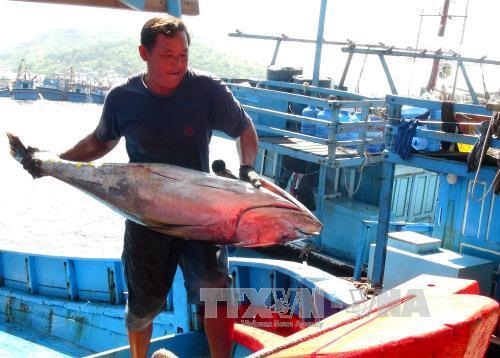 Economy
Economy

" />The People’s Committee in the south-central coastal province of Bình Thuận targets increasing by 1.3 times the coastal economic growth rate by 2020 against the current total provincial rate.
 |
| The People’s Committee in the south-central coastal province of Bình Thuận targets increasing coastal economic growth rate by 1.3 times against the total provinical growth rate. — VNA/VNS Photo Nguyên Lý |
HCM CITY — The People’s Committee in the south-central coastal province of Bình Thuận targets increasing by 1.3 times the coastal economic growth rate by 2020 against the current total provincial rate.
Nguyễn Ngọc Hai, the committee’s chairman, said the entire seafood sector would grow on average by 10 per cent, the seafood processing sector by 75 per cent, and coastal tourism by 19.3 per cent each year by 2020.
Under the plan, the province’s seafood exports would reach US$170 million by that time, he added.
To reach the goal, the province will eliminate overlapping planning and review a master plan for coastal economic development.
The province is also taking measures to follow through the Vietnam Maritime Strategy to 2020 approved by the 10th Party Central Committee’s 4th session.
Nine key tasks for effective coastal economic development include coastal exploitation only suited to local conditions and socio-economic development plans.
Policies for sustainable economic development along the coast will also be carried out.
The province has attracted investment in many fields related to development, ensuring national defence and security in coastal areas.
It has also strengthened development in infrastructure for its islands and urban areas along beaches, while many social welfare, vocational training and jobs programmes have improved the lives of local residents.
Moreover, the province has created plans to adapt to climate change and natural diasters. Rescues at sea have been enhanced to ensure safety for fishermen and boats.
Capital has also been sought from a variety of sources to invest in landslide prevention, which occurs mostly in Phan Thiết city and Phú Quý Island District.
Many areas for boats to anchor during storms have been built as well.
Bình Thuận Province has beaches with a total length of 192 kilometres and fishing grounds of 52,000 square kilometres, one of the country’s largest, with an abundant source of seafood.
The province’s sea areas are contiguous to other large fishing grounds such as Trường Sa in Khánh Hòa Province, making it advantageous to develop an offshore fishing industry.
The province has seven districts, towns, and cities located along beaches and islands.
Fishing is a traditional industry in Phan Thiết City, La Gi Town, and the districts of Tuy Phong and Phú Quý.
This area has more than 7,000 fishing vessels with engine capacity of 700,000 CV. Since 2008, more than 600 teams of fishing vessels have worked together in offshore fishing, seafood sales, and rescue at sea during emergencies.
With these vessels, fishermen can exploit nearly 190,000 tonnes of many kinds of seafood each year.
The province also has areas of alluvial ground and zones near the sea for intensive cultivation of shrimp.
It has strengthened aquatic cultivation, and now has yields of nearly 15,000 tonnes of shrimp a year.
Aquatic resources
To carry out the Việt Nam Maritime Strategy and policies on parallel exploitation and regeneration of aquatic resources, the province banned the exploitation of bivalve shellfish between April 1 and July 31 each year, which is the reproductive period for this kind of shellfish.
In addition, fishing for young lobsters is banned from March 1 to September 30 every year. The Phan Thiết City’s People’s Committee is now completing a more detailed instruction on the ban of fishing for young lobsters.
Another project involves regeneration of hair clams in Hàm Thuận Nam District’s Thuận Quý Commune.
Around 112 tonnes of hair clams were dumped into the sea, with the goal of having 10 to 15 hair clams per square metre and more than 10,000 tonnes of ouput after three years of the project’s implementation.
Since the bans took effect, more young lobsters, sea-horses and cuttle’s eggs have appeared in the sea zone.
The province has also banned the building of new ships for driftnet fishing near the shore where aquatic animals breed from April 1 to July 31. — VNS




